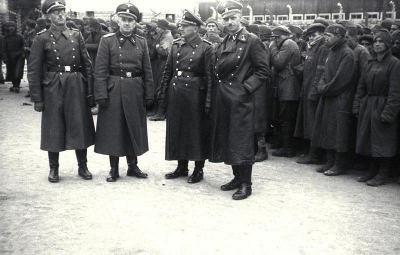Auschwitz concentration camp (German: Konzentrationslager Auschwitz (pronounced [kntsntatsionsla avts] (listen)); also KL Auschwitz or KZ Auschwitz) was a complex of over 40 concentration and extermination camps operated by Nazi Germany in occupied Poland (in a portion annexed into Germany in 1939) during World War II and the Holocaust. It consisted of Auschwitz I, the main camp (Stammlager) in Owicim; Auschwitz II-Birkenau, a concentration and extermination camp with gas chambers; Auschwitz III-Monowitz, a labor camp for the chemical conglomerate IG Farben; and dozens of subcamps. The camps became a major site of the Nazis' final solution to the Jewish question.
After Germany sparked World War II by invading Poland in September 1939, the Schutzstaffel (SS) converted Auschwitz I, an army barracks, into a prisoner-of-war camp.The initial transport of political detainees to Auschwitz consisted almost solely of Poles for whom the camp was initially established. The bulk of inmates were Polish for the first two years.In May 1940, German criminals brought to the camp as functionaries, established the camp's reputation for sadism. Prisoners were beaten, tortured, and executed for the most trivial reasons. The first gassingsof Soviet and Polish prisonerstook place in block 11 of Auschwitz I around August 1941. Construction of Auschwitz II began the following month, and from 1942 until late 1944 freight trains delivered Jews from all over German-occupied Europe to its gas chambers. Of the 1.3 million people sent to Auschwitz, 1.1 million were murdered. The number of victims includes 960,000 Jews (865,000 of whom were gassed on arrival), 74,000 ethnic Poles, 21,000 Roma, 15,000 Soviet prisoners of war, and up to 15,000 other Europeans. Those not gassed were murdered via starvation, exhaustion, disease, individual executions, or beatings. Others were killed during medical experiments.
At least 802 prisoners tried to escape, 144 successfully, and on 7 October 1944 two Sonderkommando units, consisting of prisoners who operated the gas chambers, launched an unsuccessful uprising. Only 789 Schutzstaffel personnel (no more than 15 percent) ever stood trial after the Holocaust ended; several were executed, including camp commandant Rudolf Hss. The Allies' failure to act on early reports of atrocities by bombing the camp or its railways remains controversial.
As the Soviet Red Army approached Auschwitz in January 1945, toward the end of the war, the SS sent most of the camp's population west on a death march to camps inside Germany and Austria. Soviet troops entered the camp on 27 January 1945, a day commemorated since 2005 as International Holocaust Remembrance Day. In the decades after the war, survivors such as Primo Levi, Viktor Frankl, and Elie Wiesel wrote memoirs of their experiences, and the camp became a dominant symbol of the Holocaust. In 1947, Poland founded the Auschwitz-Birkenau State Museum on the site of Auschwitz I and II, and in 1979 it was named a World Heritage Site by UNESCO.
SS-Totenkopfverbände (SS-TV; lit. 'Death's Head Units') was the Schutzstaffel (SS) organization responsible for administering the Nazi concentration camps and extermination camps for Nazi Germany, among similar duties. While the Totenkopf was the universal cap badge of the SS, the SS-TV also wore this insignia on the right collar tab to distinguish itself from other SS formations.
The SS-TV originally created in 1933 was an independent unit within the SS, with its own command structure. It ran the camps throughout Germany and later in occupied Europe. Camps in Germany included Dachau, Bergen-Belsen, and Buchenwald; camps elsewhere in Europe included Auschwitz-Birkenau in German occupied Poland and Mauthausen in Austria among the numerous other concentration camps, and death camps handled with the utmost of secrecy. The extermination camps' function was genocide; they included Treblinka, Bełżec, and Sobibór built specifically for Aktion Reinhard, as well as the original Chełmno extermination camp, and Majdanek which was fitted with mass killing facilities, along with Auschwitz. They were responsible for facilitating what the Nazis called the Final Solution, known since the war as the Holocaust; perpetrated by the SS within the command structure of the Reich Security Main Office, subordinate to Heinrich Himmler, and the SS Economic and Administrative Main Office or WVHA.At the outbreak of World War II in Europe, the SS Division Totenkopf was formed from SS-TV personnel. It soon developed a reputation for brutality, participating in war crimes such as the Le Paradis massacre in 1940 during the Fall of France. On the Eastern Front, the mass shootings of Polish and Soviet civilians in Operation Barbarossa were the work of Einsatzgruppen mobile death squads and their subgroups called Einsatzkommando. These units were organized by Heinrich Himmler and Reinhard Heydrich.

1945Jan, 17
The SS-Totenkopfverbände begin the evacuation of the Auschwitz concentration camp as Soviet forces close in.
Choose Another Date
Events on 1945
- 23Feb
Manila
World War II: The capital of the Philippines, Manila, is liberated by combined Filipino and American forces. - 23Feb
History of Poland (1939-45)
World War II: Capitulation of German garrison in Poznań. The city is liberated by Soviet and Polish forces. - 25Feb
Turkey
World War II: Turkey declares war on Germany. - 9Mar
Atomic bombings of Hiroshima and Nagasaki
World War II: The first nocturnal incendiary attack on Tokyo inflicts damage comparable to that inflicted on both Hiroshima and Nagasaki five months later. - 30Aug
Douglas MacArthur
The Supreme Commander of the Allied Forces, General Douglas MacArthur lands at Atsugi Air Force Base.

 English
English  español
español  français
français  português
português  русский
русский  العربية
العربية  简体中文
简体中文 